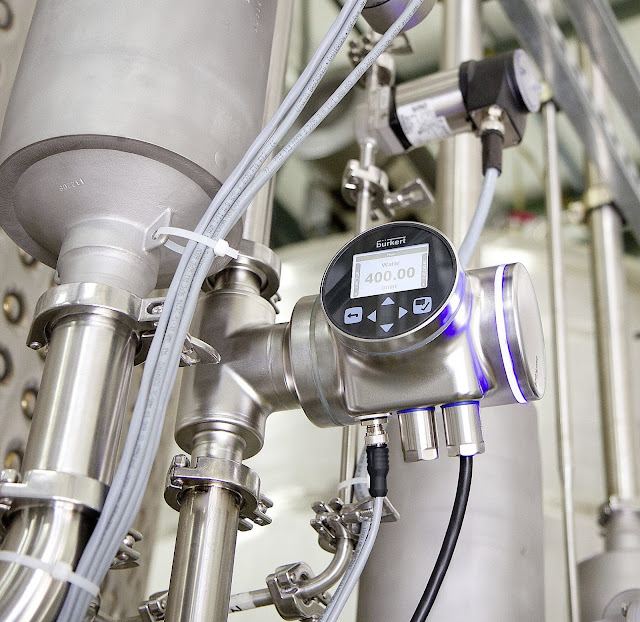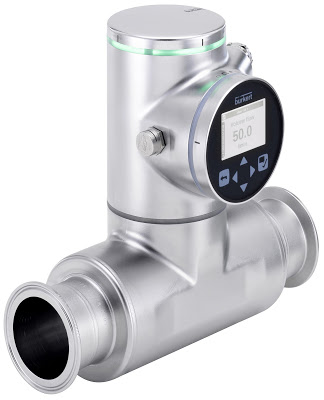The flow meter operates according to the patented SAW process (Surface Acoustic Waves), which uses surface waves to perform measurements (see Technology section). The primary advantage of this process is that there are no installed fittings or constrictions, which also means there are no empty spaces in the measurement tube. In addition, measurements are performed without any contact between the sensor elements and the medium; the liquid neither affects the sensor elements nor can the sensors contaminate the medium. This is not only hygienic, but also simplifies the cleaning process (hygienic design). The fact that the measuring tube is identical to every other straight tube section in the system in fluidic terms it also avoids pressure drops. Furthermore, installation is extremely straightforward thanks to the compact size and low weight of the device.
FLOWave consumes much less energy than Coriolis flowmeters, for example, and can be mounted in any installation position. Measurements can be taken in standing liquids in fast-flowing liquids or in liquid flows that change direction. In addition, no maintenance work is required, which can significantly reduce the operating costs.
Precise and future-proof:
The compact flow meter manufactured entirely from stainless steel measures the volume flow with an accuracy of 0.4 % of the measured value. Temperature is measured simultaneously with an accuracy of ≤ 1 °C. Depending on the orifice, the nominal pressure can be up to 25 bar. The temperature range is designed to enable CIP as well as SIP cleaning processes. The measuring device is available with tube orifices DN15, DN25, DN40 as well as DN50 with tube and clamp connections according to ASME and ISO. It can be used with or without a display.
The FLOWave transmitter is based on the EDIP (Efficient Device Integration Platform) electronics platform, which enables networking with other Bürkert devices to create an intelligent system. This makes the devices much easier to handle and to integrate into an existing application. Besides measuring volume flow and temperature, the next step in the FLOWave enhancement will add measured values such as the density factor (for liquid detection) and the acoustic transmission factor (for detecting gas bubbles). Validations are currently being conducted for food oils, yoghurt, baby food, adhesives, paints and engine oils. FLOWave is already being used with great success in watery media such as acids, lyes, condensates and especially in non-conductive water.
Proven in the pharmaceutical industry:
In the pharmaceutical industry, FLOWave has already proven to be extremely effective in numerous different applications, such as the flow measurement of costly ultrapure water (Image 2 and 3), the mixing of intravenous infusions, in numerous dosing and monitoring tasks using different liquids required for production as well as in critical CIP and SIP processes in which both flow and temperature must be monitored.


Technology:
The Surface Acoustic Wave (SAW) technology employed here uses a similar type of wave propagation that occurs during seismic activities (e.g. earthquakes). The main part of the sensor consists of a measuring tube whose surface is fitted with a series of interdigital transducers.
These transducers trigger the wave propagation by electrical excitation. The FLOWave technology functions with four transducers, which can each act as transmitters and receivers. If one is active as a transmitter, the two most distant sensors function as receivers. The surface waves generated at the surface of the tube also couple out into the fluid.
The coupling out angle depends on the relation between the propagation speed of the surface wave and the propagation speed in the liquid. On the other side of the measuring tube, the waves couple back into the measuring tube and run to the next transducer. Consequently, the excitation of each transducer leads to a sequence of received signals at two other transducers. Two transducers transmit in the flow direction, and two in the opposite direction.
The volume flow is proportional to the time difference of wave propagation in the forward and reverse directions. What is particularly noticeable in this context is that it is possible to compare measured values that are derived from passing through the fluid once to several times. With the help of corresponding mathematical evaluations, they reveal information about the liquid itself.









































Interested? Submit your enquiry using the form below:
Only available for registered users. Sign In to your account or register here.